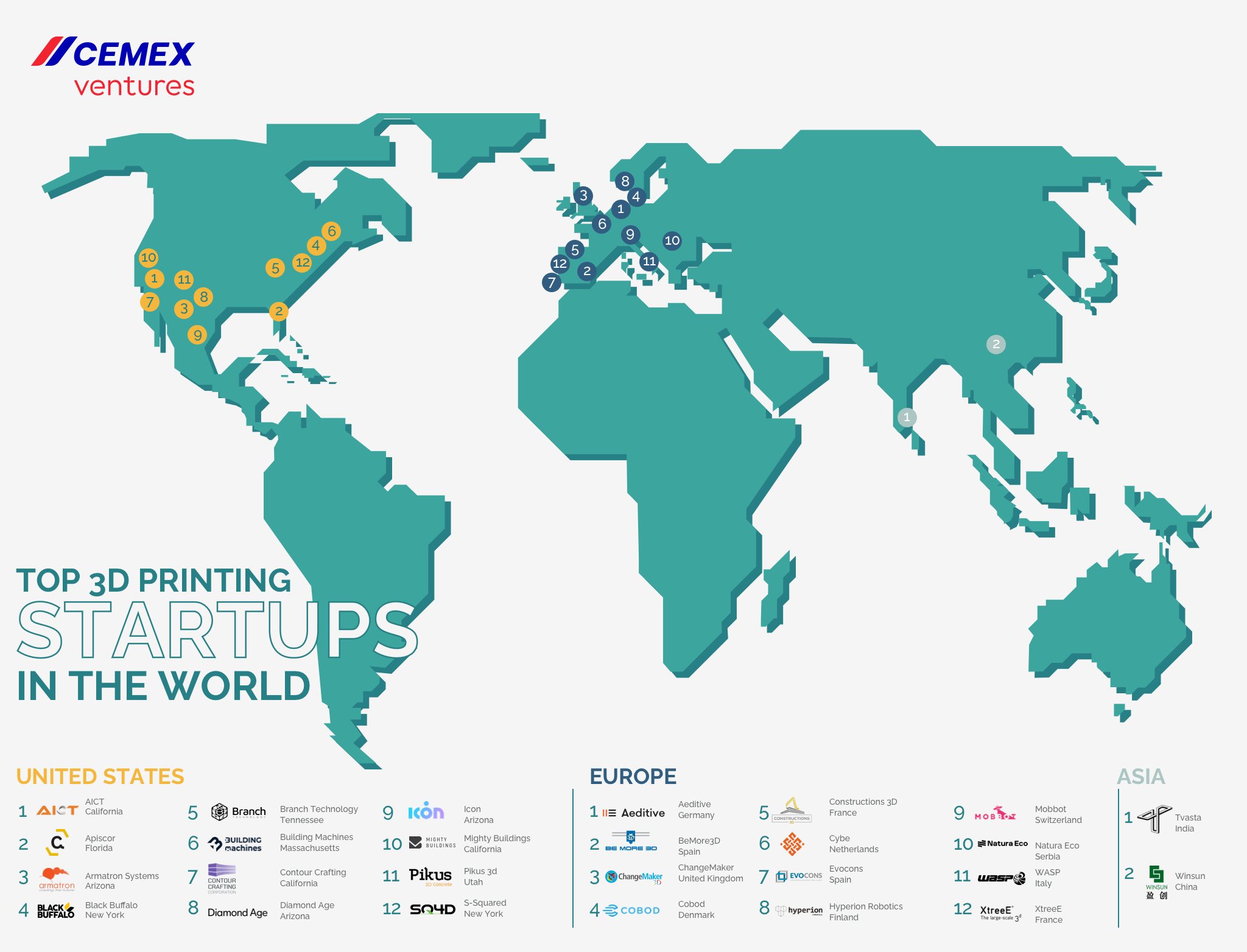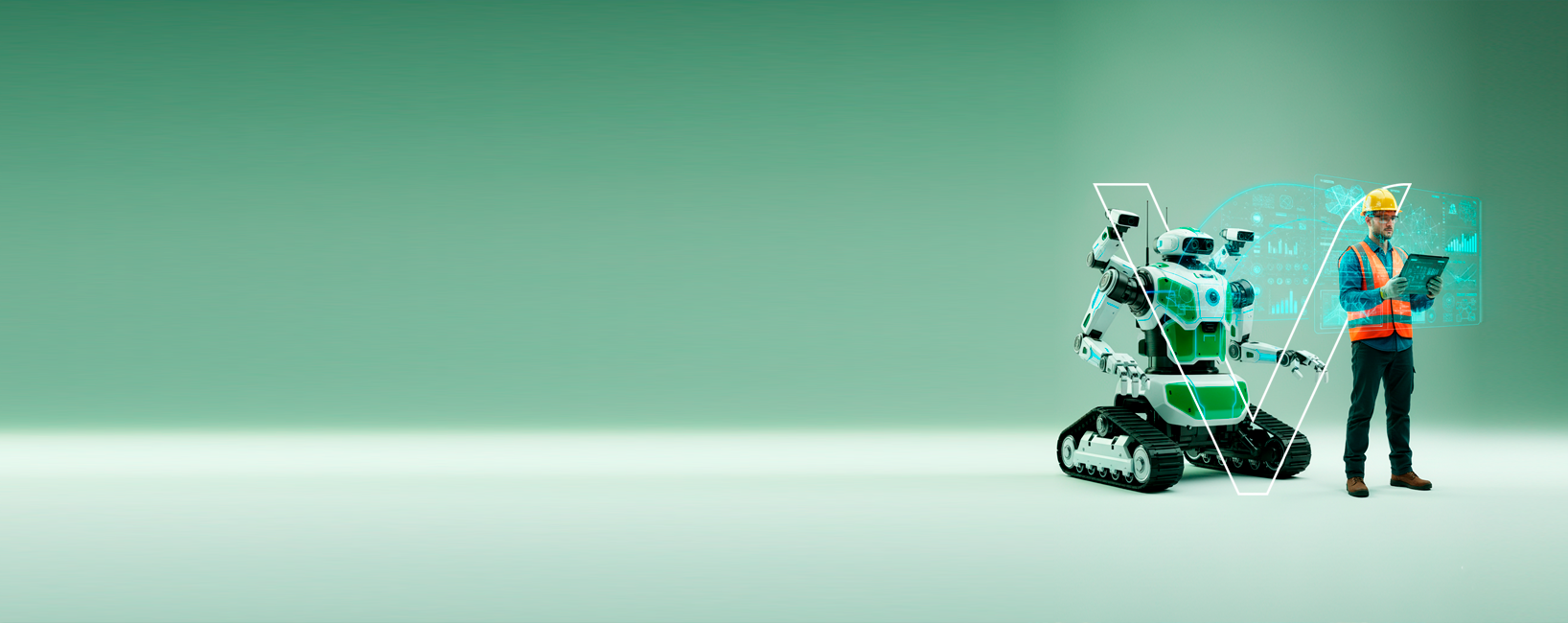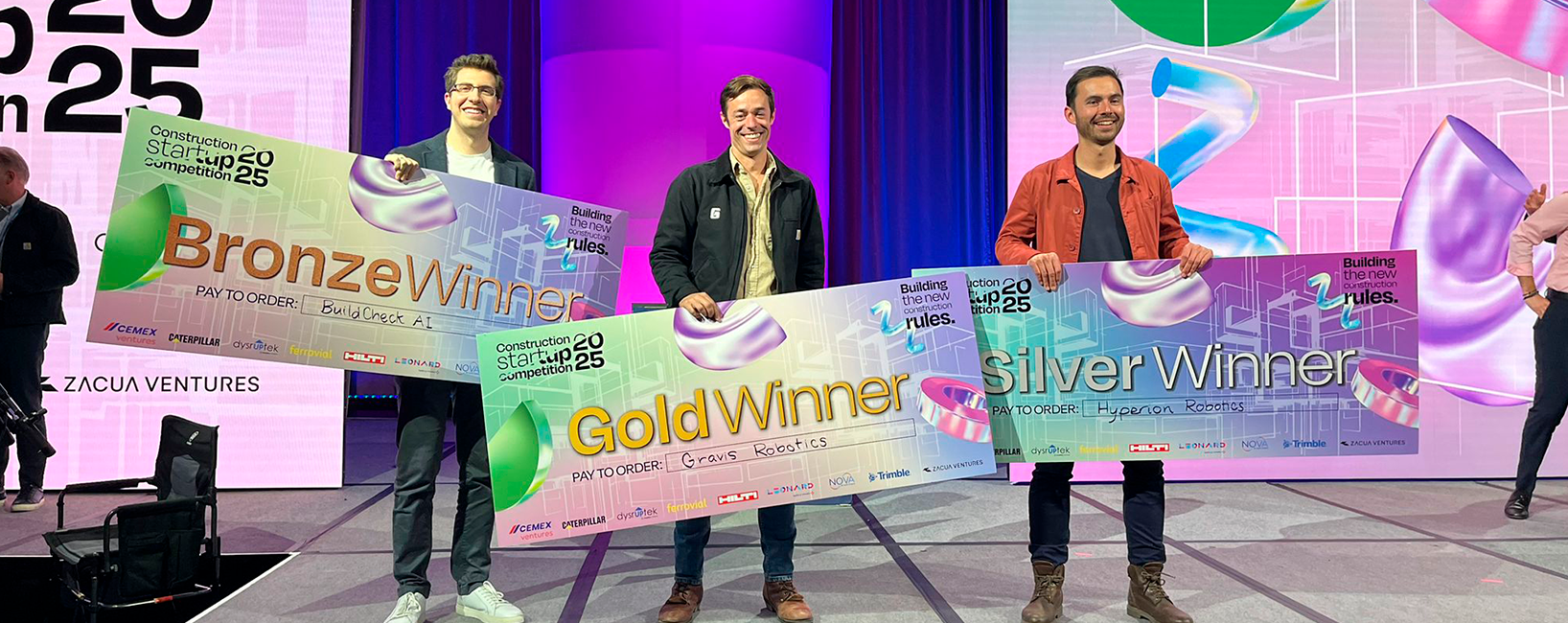3D printing is one of the greatest technological advances and innovations of the 21st century. Its value in the global market reached $190 million (USD) in 2021, and is expected to increase to $680 million (USD) by 2030. The factors that most influence this growth are the increase in environmental concerns regarding the waste generated by the sector, the possibility of customization and architectural flexibility using this technology, and the rapid creation of models and prototypes.
As the technology continues to develop, the possibilities for adoption and growth increase, and by 2028 its compound annual growth rate (CAGR) is expected to be of 91.5% compared to 2021. How do we see the evolution of 3D printing in the construction industry from Cemex Ventures?
Table of Contents
What is 3D printing in construction?
3D construction printing (3DCP or 3DP) refers to the automated process of manufacturing construction elements or entire structures by means of a 3D printer.
However, instead of using ink like the traditional printers we’re used to, construction materials are printed layer-upon-layer, which is also why 3DCP goes by the name additive manufuacturing or additive construction. It can be carried out both onsite and offsite.
How does 3D printing work in construction?
The technology around 3D printing has been questioned many times since the 1980s. However, it has gained greater relevance thanks to the improvement of the technique itself that allows for the creation of a three-dimensional object by superimposing successive layers of material. This method of construction is very versatile and can help create specific components of a project and even various types of complex structures in its entirety such as houses or living spaces, offices, bridges, walls, modular structures, reinforcement molds, columns, urban furniture and even decorative elements. How is this possible?

In construction, much of the information needed to make this technology work comes from the design process. As the industry already has experience in the computer-aided manufacturing process and BIM(Building Information Modeling) continues to bloom in the construction sector, the integration of 3D printing technologies is less complicated. Using a CAD or BIM program, a 3D printer receives the information of what it needs to print, and machines begin to overlay material levels according to the indications. This can be done with various materials, the most common being a mixture of concrete, geo polymers, fiber, and sand.
The evolution of 3D printing has been so favorable in the last decade, that its value in the construction market is expected to reach up to USD $ 1,034,096.7 thousand by 2028, according to a study by Research and Markets. This represents a 91.5% increase in its compound annual growth rate between 2021 and 2028.
Benefits of 3D printing in construction industry
3D printing brings great benefits to the construction industry, being a solution that touches almost all areas of the value chain of the sector. From contributions to sustainability, increased productivity and support in challenges on the supply chain, this technology came to revolutionize the way we build.
Time reduction
With traditional construction methods, a project can take many months to complete, with the norm being that large projects take 20% longer than expected and adding up to 80% in cost overruns over the initial budget. However, 3D printing allows to reduce up to 70% of the time and a project can be completed in just hours or days, depending on its magnitude. Therefore, contractors can work on more projects and, consequently, increase their source of income.
More cost-effective and sustainable
3D printing allows the precise amount of material to be used to lift a structure, allowing up to 60% less waste to be generated at the jobsite. Likewise, there will be no surplus in the purchase of materials, assuming a reduction in costs both in its purchase and subsequent storage.
By reducing time and costs, companies will see an exponential increase in the benefits of this technology, which is also of great help in locations where there is a need for projects and a shortage of labor. By automating the creation of a structure through 3D printers, companies can see a reduction in labor costs of up to 80%.

Safer
The U.S. Occupational Safety and Health Administration (OSHA) reports that 1 in 10 workers on construction sites is injured each year, with falls and wrongful contact with equipment being the main causes.
One of the most important benefits that 3D printing has brought to construction is in the health and safety of the employees onsite. By knowing how to work effectively with printers, workers can do their jobs more easily and reduce injuries in the field.
Design flexibility
Last-minute changes to the design will no longer be a problem nor delay the construction process. 3D printing allows you to customize the work until just before starting the printing of the structure, eliminating all the headaches that these changes entail.
Opportunities and challenges for 3D printing in construction
Although the benefits of 3D printing in construction will continue to develop as more companies bet on this technology, achieving greater adoption of this method in the market is still a challenge.
We highlight the following points that intervene when making this technology even more trendier among industry professionals and why large companies are still dubious about it:
- Although 3D printing itself is more cost-effective when building, the necessary machinery continues to be very expensive both to acquire and to operate it, and large companies still do not bet on them in a significant way.
- The industry needs to develop more trained professionals to be able to handle the technology behind 3D printing, trained to design computer models, operate the equipment and provide proper maintenance.
- More regulations and legislation are needed for 3D printing in construction that allows for clear guidelines on its use and benefits of its implementation in new construction sites.
Likewise, the sizes and development of printers are a challenge because many of the models that emerge in the market limit their use to the size of the structure to be printed.
In addition, the material or formula of the mixture in which it is printed is one of the main limitations for 3D printing to stand out as a construction method. The material on which it is printed must have the desired printing capacity to be able to be extruded from the nozzle, and the buildability to be able to maintain its shape and sustain itself quickly.
In addition, the open time, which is the period where printing and buildability are consistent within the acceptable tolerances since there is a limited time to print the material, become a main challenge. Any delay in the process can cause the concrete to harden and hinder the work.

Types of 3D printers
Robotic arm
Automatically controlled printer that allows freedom of movement and flexibility to schedule multiple tasks. The arm is capable of printing from multiple angles, allowing the realization of complex geometries and curves, and printing in larger sizes compared to other 3D printing methods.
Gantry system
The contouring method marks the beginning of 3D printing in construction. This process deposits building material to form a 3D model and create large-scale structures with a smooth surface finish. It works with rails placed around the floor of the building that act as a guide to direct the robotic arm in the application of the concrete layer by layer.
3D printing technology in construction
Methods
There is no one-size-fits-all 3D printing construction technology. Depending on the specifics of the project, different printing methods can be employed. These are the most common:
- Extrusion: Extrusion is the most common 3D printing technique as it can be used in almost all environments. Commonly used for modeling, prototyping and production applications, this method creates an object by layering material back and forth through one or more nozzles mounted on a robotic arm, gantry system or crane.
- Powder Bonding: Contrary to other 3D printer construction methods, powder bonding uses powdered raw material as its main component. There are two methods: powder bed jetting and binder jetting. The first is characterized by melting dust particles with a laser on the desired object layer by layer, while a coating sheet adds more material for each new layer. On the other hand, the binder jetting uses a print head that deposits a liquid adhesive agent on the powder printing bed. The liquid binds the powder particles together to form each layer of the desired object. Then a new layer is added, and the process is repeated layer by layer. This one allows printing with a higher level of accuracy and can handle more complex prints.
- Spray: The autonomous robot sprays the construction material under pressure in the desired shape and repeats the process layer by layer. This method allows to fill the spaces of the structure with concrete, and its use is currently being studied for vertical and outstanding applications such as facades or ceiling decorations.
Materials
Once the 3D printed construction method has been selected, it’s time to choose the material that will be used. Recent advances in construction 3D printing have increased the number of different materials available. The material selected should depend on the type of project in question, however, the most common materials used are:
- Standard concrete,
- Proprietary concrete mixes,
- Mortar,
- Plastic,
- Metal, and
- Local natural materials (stone, sand, mud, rice waste, etc.)

3D printing in construction worldwide
The demand for construction and better infrastructure is growing, especially in large cities. In 1800, only 3% of the population resided in urban areas; by 1900, the total population living in cities increased to 15%. Today we reach 55% of humanity residing in urban areas and the World Economic Forum predicts that two-thirds of the population will live in large cities by 2050.
On a global scale there are numerous government measures that encourage the implementation of 3D printing under construction. Several cities are running to win this race and one of those that opts to lead the list is Dubai, where 25% of buildings have to be made with 3D printing technology by 2030.
What does the situation of this technology look like in the world?

America
- The United States was the first country to bet on 3D printing technology in construction and leads the number of projects being done in North America.
- Large organizations such as the US. Navy and NASA are involved in projects in North America.
- Mexico is the country that has the most projects in Latin America.
Europe
- It leads the number of projects developed worldwide, with the Netherlands being the main node for research and development (R&D).
- In recent years, France, Germany, Spain, the United Kingdom and Italy have gained prominence.
- Universities take a very strong role in the R&D efforts for 3D printing in construction and get involved in its execution with companies.
- They raise environmental and sustainable benefits.
Asia and the Middle East
- In 2020, 38% of the market share with respect to 3D printing in construction corresponds to Asia Pacific, largely due to the lucrative opportunities in the sector for this region.
- The government of Dubai, where the world’s largest government building was built using only 3D printing, has pledged that 25% of new constructions will be carried out with this technology by 2030.
- China was a pioneer in the technology´s development, but in recent years other countries take advantage of it and Japan joins as one of the most promising countries in the development and implementation of technology.
- Most of the projects are considered commercial and universities are becoming more relevant in the evolution of the technologies.
- They print other structures and prototypes beyond houses, such as bridges.

Startups working in 3D printing
The enormous work that startups are doing to promote the adoption of 3D printing in the construction industry is proof that the contech ecosystem is dominated by entrepreneurs who dare to bet on innovative technologies. More often, these projects are being supported by big names in construction, a result of the growth that this technology is having in the global market.
In this table we show the most competitive startups on a global scale that work in 3D printing for the construction industry, as well as:
- Material used. Although most use mortar, some use plaster or natural materials such as soil or mud.
- Print Location. Many move the machine to print in the selected space, although more and more companies appear that do it first in the factory and then transport it to the construction site.
- Applications that print entire houses, parts of houses, structures, or objects (such as street furniture).
- They can use the robotic arm or shaft system. The robotic arm usually moves throughout the structure and has more freedom of movement. On the other hand, the shaft system is more limited, does not move, and prints only where the machine falls.
|
Company |
Country |
Material |
Printing location |
Relevant applications |
Printer type |
|
Germany |
Morter, Concrete |
Offsite |
Structures |
Robotic arm |
|
|
United States |
Morter |
Onsite |
Houses, Structures |
Robotic arm |
|
|
United States |
Morter, plaster and others |
Onsite |
Houses |
Robotic arm |
|
|
United States |
Morter |
Onsite |
Houses, Structures |
Robotic arm |
|
|
Spain |
Morter |
Onsite |
Houses, Structures |
Gantry system |
|
|
United States |
Morter |
Onsite |
Houses, Structures |
Gantry system |
|
|
United States |
Polymers |
Offsite |
Structures |
Robotic arm |
|
|
United States |
Morter |
Onsite |
Houses |
Robotic arm |
|
|
United Kingdom |
Morter |
Onsite, offsite |
Houses |
Robotic arm |
|
|
Denmark |
Morter, Concrete |
Onsite |
Houses |
Gantry system |
|
|
France |
Morter |
Onsite |
Prototypes, objects |
Gantry system |
|
|
United States |
Morter |
Onsite |
Houses |
Gantry system |
|
|
Netherlands |
Morter |
Onsite |
Houses, Structures |
Robotic arm |
|
|
United States |
Morter |
Onsite |
Houses |
Gantry system |
|
|
Spain |
Morter |
Onsite |
Houses |
Gantry system |
|
|
Finland |
Concrete |
Onsite |
Structures |
Robotic arm |
|
|
United States |
Morter |
Onsite |
Houses |
Gantry system |
|
|
United States |
Composite materials |
Offsite |
Houses |
Gantry system |
|
|
Switzerland |
Morter |
Onsite |
Structures |
Robotic arm |
|
|
Serbia |
Morter |
Onsite |
Houses |
Gantry system |
|
|
United States |
Morter |
Offsite |
Street furniture |
Robotic arm |
|
|
United States |
Concrete |
Onsite |
Houses |
Gantry system |
|
|
India |
Morter |
Onsite |
Houses |
Gantry sysem |
|
|
Italy |
Natural materials |
Onsite |
Houses |
Cable-driven parallel robot |
|
|
China |
Morter and others |
Onsite/offsite |
Houses, Panels |
Gantry system |
|
|
France |
Morter |
Offsite |
Columns, Panels, Prototype |
Robotic arm |
Cemex Ventures and its commitment to 3D printing in construction industry
As we work to transform construction into a more efficient, sustainable and innovative industry, Cemex Ventures is actively looking for solutions and entrepreneurs in the construction 3D printing space.
A decade ago, 3D printing in construction at the scale it is used today was almost unthinkable, since it was too expensive and too difficult to scale across global markets. However, as we look toward 2030, 3D printing construction options are becoming more and more complete and available, offering immense benefits to stakeholders across the entire construction value chain.
An example of this is Cemex’s close collaboration with 3D printing startup COBOD. The two companies have worked to convert traditional concrete used in 3D printing into a more versatile aggregate called D.fab that takes shape instantly and is compatible with COBOD’s 3D printing machinery. Both companies have developed and perfected the technology, allowing them to carry out numerous projects including one of the world’s largest buildings to ever be 3D printed from real concrete in Oman.
Moreover, since 2017 we have kept an eye out for all the participating startups of Construction Startup Competition with solutions that apply to the Future of Construction vertical, paying close attention to those related to 3D printing.
After 7 years we have seen 3D printing technology in construction improve by leaps and bounds and with forecasts clear for the coming years, we will see this trend continue upward.
If you have a startup developing 3D printing for construction, or you are looking to expand your portfolio of customers and markets, we only have to say one thing: the ground is fertile, the light is green, and the time is now. Contact us and let’s start a conversation (no bots, we promise!).


